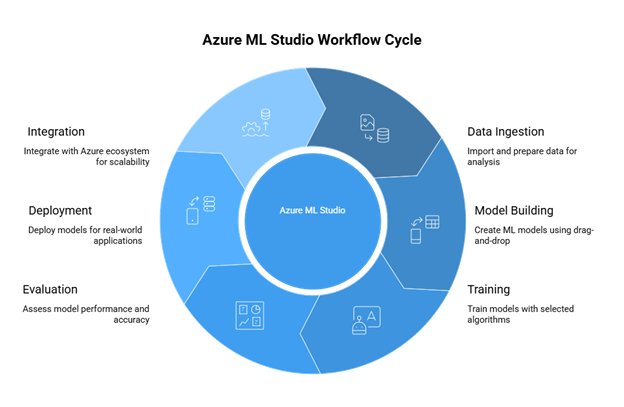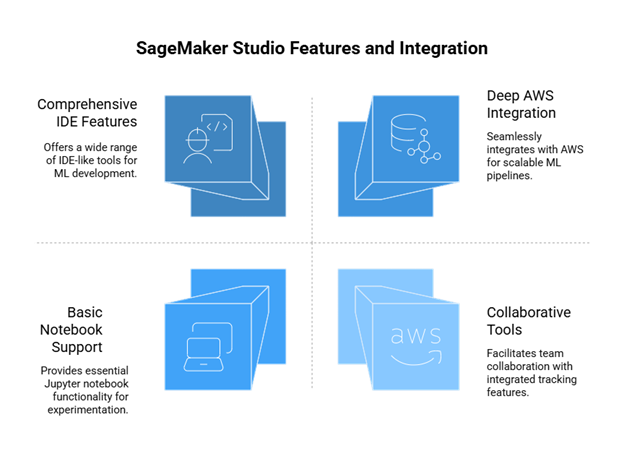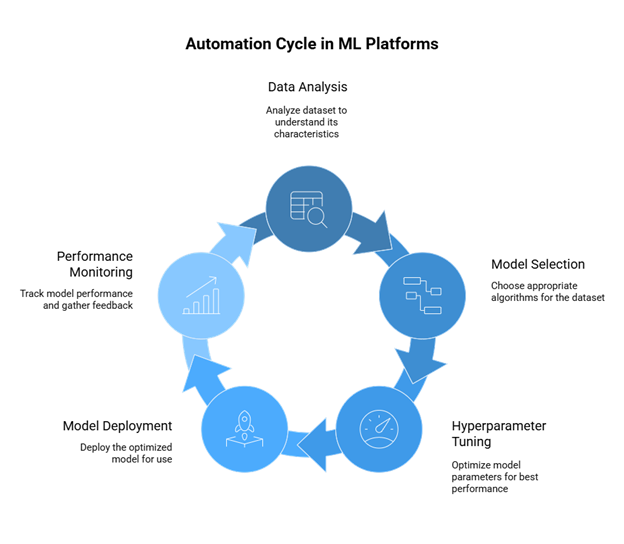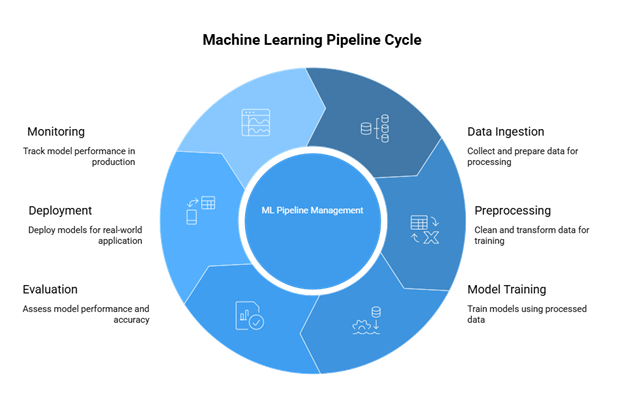AWS SageMaker vs Azure Machine Learning: Key Differences

With AI leading industry transformation, cloud ML platforms have come to represent tools that businesses must have in order to build intelligent applications. Azure Machine Learning and AWS SageMaker are two of the most powerful platforms in this space that allow users to develop, train, and deploy ML models at scale. Since both Microsoft and Amazon have quite formidable ML ecosystems on offer, the choice between AWS SageMaker vs Azure Machine Learning always arise. The right platform can make a substantial impact on how efficiently, scalably, and cost-effectively you could do this product.
In this blog, we aim to give you an Azure ML vs AWS SageMaker comparative analysis so that you can get to know the main differences, strengths, and weaknesses of either one. Be it for you as a data scientist, developer, or business decision-maker, understanding what each platform offers will help you in deciding which one is best suited for your unique use case.
We will look at distinctions between the platforms, including things like development environments, automation features, deployment options, pricing, and ecosystem integration. This will give you direct, actionable points of comparison of AWS SageMaker vs Azure Machine Learning across many axes to help you make an informed decision in your AI journey. Let’s start with a high-level overview of both platforms.
Table of Contents
Overview of the Platforms
The higher the demand for AI solutions, the more crucial choosing the right machine learning platform has become for businesses and developers. This creates one of the most typical comparison points between teams evaluating cloud-based ML services: AWS SageMaker and Azure Machine Learning. Both platforms comprise tools to enable the building, training, and deployment of ML models, but they are structured and designed around disparate features, workflows, and ecosystems. Below, I will attempt to place each platform in context, describing what it does, who it serves, and how it fits within its cloud ecosystem.
What is Azure Machine Learning?
Azure Machine Learning is Microsoft’s enterprise-grade cloud machine learning platform built to nurture the entire ML lifecycle, from data preparation to model deployment and monitoring. It allows data scientists and developers to build, train, and deploy machine models quickly and efficiently and incorporates a wide variety of tools such as Python SDKs, CLI, and a friendly graphical interface through Azure Machine Learning Studio.
It is tightly integrated into the Microsoft Azure ecosystem, allowing seamless interoperability with services such as Azure Data Factory, Azure Synapse Analytics, or Power BI; hence, it will be of particular interest to organizations that have invested heavily in Microsoft technologies. Azure ML is packed with features that promise automated ML, scalable compute options, and MLOps capabilities to suit everyone from novice data scientists to industry experts in fields like finance, healthcare, and manufacturing.
Read More: What is Azure Machine Learning: A Beginner’s Guide
What is AWS SageMaker?
AWS SageMaker is Amazon Web Services’ complete ML cloud platform intended to help developers and data scientists in building, training, and deploying models at scale. A full-managed environment is offered where users can use built-in algorithms, pre-configured Jupyter notebooks, and a powerful reinforcement of tools to smooth the whole ML workflow.
The key features include SageMaker Studio for the IDE, or SageMaker Autopilot for AutoML tasks, plus scalable compute resources. It works with popular frameworks such as TensorFlow, PyTorch, and MXNet, and is thus well-suited to organizations that rely on the AWS infrastructure. Its modular architecture allows users to decide which components they want to use, adding a great deal of flexibility for any number of ML tasks, ranging from simple experimentation to complex production deployment. In line with AWS, it makes an excellent add-on for any company using existing AWS services such as S3, Lambda, and Redshift to incorporate ML capabilities.
Development Environments
One of the most important things to consider when examining AWS SageMaker vs Azure Machine Learning is the development environment it offers. How easy is it to build and deploy models? Does the environment support collaboration and scalability? Answering all those questions first needed first explaining what these two high-profile interfaces are meant to achieve: Azure ML Studio and SageMaker Studio. Both intend to ease and speed up the ML workflows.
Get started with Azure ML
What is Azure Machine Learning Studio and How Does It Work?
Azure ML Studio is Microsoft’s easy-to-use environment for building machine-learning models with zero or minimal code. Intended to make ML workflows as simple as possible for anybody who is building, training, and deploying models, this simple drag-and-drop interface supports rapid experimentation and enterprise-scale deployments by complementing Azure in the larger sense.

Visual and Drag-and-Drop Interface for easy ML development.
Azure ML Studio is clean and was designed for users to create ML pipelines without heavy coding. The drag-and-drop capability is very useful; for example, the user can drag in their dataset, apply a few transformations, and configure the training algorithm. It really simplifies ML development for anybody who might not feel comfortable coding themselves, like business analysts or domain experts.
SDK & Notebook Support for Advanced Workflows
Studio is great for beginners but can also be useful for an advanced user. It supports Python SDKs and Jupyter notebooks. That means a good place to debug widgets with custom code coming from deep model fine-tuning and analysis. So, it offers a mixed environment for users, sometimes inspiring temporary visual workflows and other times just coding directly.
Automated ML for Fast Prototyping
Azure Machine Learning Studio has AutoML features that automate the selection of models, training, and hyperparameter tuning. All users need to do is enter their data and define the goals, while the platform goes on and identifies the best-performing model. It speeds up experimentation and enables users with very little work to obtain superior results.
Together with Azure Ecosystem
The Studio integrates suppressfully, accommodating Azure Data Lake, Synapse Analytics and Power BI into the fold. This provides end-to-end workflows, from data ingestion, analysis, visualization, and finally, model deployment in a unified environment. Such integration increases productivity while enabling enterprise-scale ML projects.
What is SageMaker Studio and Why Do Developers Prefer It?
Amazon SageMaker Studio is an IDE for Machine Learning fully integrated by Amazon, designed to support end-to-end ML workflows. It hosts a code-centric view with very powerful tools integrated within so that developers and data scientists can build, train, and deploy their models with efficiency and ease. Being a part of AWS means it nests deeper into cloud services, making it suitable for teams looking to scale and gain flexibility.

An IDE-Like Environment for Professional ML Development
Akin to a fully featured modern IDE, SageMaker Studio offers file browsing, terminal access, and source control integration. In one interface, users can manage code, datasets, and ML experiments. Hence, the environment is suitable for those who wish to have hands-on control and advanced workflow customization.
Fully Integrated Jupyter Notebooks for Experimentation
Within Studio, SageMaker users can open Jupyter notebooks with a single click. These notebooks support major ML frameworks such as TensorFlow, PyTorch, and Scikit-learn. The notebooks themselves are tightly integrated with AWS services, making it easy to get at data in S3 or deploy models in very short order.
Tracking and Collaboration Tools
The Studio in SageMaker comes equipped with built-in features such as experiment tracking, model versioning, and real-time monitoring. There is a user interface that allows users to compare results, view logs, and administer resources in one place. Collaborative development is also very well supported with shared notebooks and role-based access control.
Deeply Integrated with AWS Services for Scalability
SageMaker Studio fits very smoothly with various AWS services such as S3 for data, Lambda for automation, and Redshift for analytics. This allows users to build scalable ML pipelines that directly fit within their current cloud infrastructure. The modular design allows for much flexibility depending on the size and complexity of every project.
What Are the Automation Capabilities of Azure ML and SageMaker?
Automation is a key differentiator when weighing SageMaker Studio vs Azure ML Studio Learning. Both systems work towards providing the shortest time-to-market for the ML lifecycle, with automated tools that select models, tune hyperparameters, and deploy them. This section looks at the automation features that save users’ time, enhance ease of working, and achieve results that are consistent and of high quality.

Automated Machine Learning (AutoML) in Azure ML
AutoML allows users to automate model selection and training in Azure ML. Essentially, by providing little input, AutoML selects algorithms and hyperparameters suited to the dataset and type of problem. The end-user can access training logs, get performance reports for various models, and deploy the most effective one in just a few clicks. Interestingly, this is a feature much appreciated by business analysts or developers that do not have any deep ML experience.
SageMaker Autopilot for End-to-End Automation
SageMaker Autopilot is Amazon AutoML for automating the entire ML pipeline, from data preprocessing to model deployment. The system analyzes the dataset with minimal input requirements from the user and chooses algorithms accordingly, tuning them to perform best. Autopilot is distinguished further by the fact that it is transparent- allowing the users to inspect the code and logic behind the models it puts forth. Hence, one of the big selling points is that you can have automation and still give advanced users the option for customization.
Hyperparameter Tuning and Model Optimization
Both platforms offer hyperparameter tuning as a managed service. On Azure ML, one can tune parameters automatically via HyperDrive, while SageMaker utilizes Automatic Model Tuning for the same purpose while also increasing the advantages of accuracy and efficiency. They are search methods that test multiple configurations in an intelligent manner, thus saving time and effort from manual tuning. It allows the models to be tuned to perform optimally without expending human effort on trial and error.
Explore Azure ML now
How Do Azure ML and SageMaker Handle Machine Learning Pipelines?
Attempting to juxtapose the realms of AWS SageMaker vs Azure Machine Learning is that the creation and management of end-to-end machine-learning workflows must occur. A sufficiently robust machine-learning pipeline will be able to automate and orchestrate preparation of data, training, and eventually validation and deployment of models. This section considers the approach that each platform has taken toward pipeline management to encompass scalable and repeatable ML solutions.

Pipeline Creation in Azure Machine Learning
Azure ML provides a prescribed pipeline feature into which users might build a reusable workflow. These pipelines might handle modular components such as data ingestion, preprocessing, model training, and evaluation. Azure pipeline interface can be made visual through Studio or code-based through Python SDK, providing flexibility depending on a userís skill set. This way of implementation ensures the consistency of experiments and makes it simple for lifecycle management of models.
Pipeline Management in AWS SageMaker
Providing a native feature for developing and handling ML workflows, SageMaker presents SageMaker Pipelines. Those pipelines utilize a Python SDK and have close integrations with other tools of SageMaker, notably training jobs and model registries. Pipelines provide a series of steps to execute, conditional logic, and real-time monitoring that facilitates managing complicated workflows. With this, developers can automate and parameterize their ML processes that scale with growth.
Workflow Automation and Reusability
Both Azure and SageMaker focus on providing an automated workflow to speed up efficiency and repeatability. Azure pipelines are integrated with GitHub, Azure DevOps, and other tools for CI/CD workflows. SageMaker Pipelines offer versioning and parameterization to create reusable templates. Such offerings accelerate the management of various projects, iteration speed, and maintaining excellent ML deployments.
How Well Do Azure ML and SageMaker Integrate with Their Cloud Ecosystems?
The main factor in considering AWS SageMaker vs Azure Machine Learning is the integration with temperate cloud ecosystems-if the organization is already somehow engaged in either Microsoft Azure or Amazon Web Services. Seamless integration better facilitates data flow, resource management, and scalability across enterprise systems. Here, we observe whether or not both platforms work well within their cloud environments.
Integration in Azure ML
Azure ML is intensely integrated with the Microsoft Azure ecosystem and, thereby, connects smoothly with services such as Azure Data Lake, Azure Synapse Analytics, Power BI, and Azure DevOps. This close integration makes it possible for users to work on data pipelines, view insights, and automate workflows- all in the same environment. Such a tight-knit integration saves time, allowing the enterprise to focus on profit-generating activities. Enterprises that espouse Microsoft technologies greatly benefit from this sort of integration.
Amazon Cloud Services Integration
amazon sagemaker offers equally strong integration within the AWS ecosystem. It connects easily with AWS services like S3 (for data storage), Lambda (for serverless computing), CloudWatch (for monitoring), and SageMaker Ground Truth (for data labeling). This unified access to cloud resources enables scalable, secure, and efficient machine learning workflows. Organizations already leveraging AWS benefit from a cohesive and optimized infrastructure.
Multi-Cloud and Hybrid Support
Both platforms support a hybrid and multi-cloud scenario in one way or the other. Azure ML integrates with on-premises resources using Azure Arc and edge deployment is also supported. SageMaker supports hybrid deployment as well as on-premises data through AWS Outposts. In this way, the capability sustains flexibility for enterprises with diverse infrastructural needs.
How Does Azure Machine Learning Integrate with Microsoft Azure Services?
Azure ML stands apart because of its seamless integration with the larger Microsoft Azure ecosystem. This deep integration empowers organizations to train, build, and deploy machine learning models in an efficient manner, while they can simultaneously benefit from Microsoft’s capable cloud service, enterprise-grade security, and pleasant development tools.
Integration with Azure Data and Analytics Services
Azure ML integrates natively with Azure Data Lake for scalable data storage and with Azure Synapse Analytics for data warehousing and big data analytics to access data efficiently and perform real-time analysis so that model training and insight derivation happen faster within a single data ecosystem.
Support for DevOps and Automation
Azure ML works with Azure DevOps to provide the CI/CD pipeline for ML workflows. Developers can use this setup to automate retraining of models, versioning, and deployment so that they can focus on the actual MLOps activities rather than juggling with third-party tools and cumbersome configurations.
Enhanced Visualization and Reporting
Integrated natively with Power BI, Azure ML can visualize model outputs, track performance, and offer interactive reports. This helps the decision-making process to be data-driven and allows the business personnel to draw insights without getting into technical ML details.
Enterprise Security and Identity Management
Azure ML uses Microsoft Entra ID (formerly Azure Active Directory) to provide user authentication and role-based access control, which ensures the highest level of data privacy, compliance, and governance would be in place, making Azure ML suitable for regulated industries.
Unified User Experience in Azure Portal
All Azure ML features get offered through data management, model training, and deployment. This very central single interface allows for a technically smooth operation, basically meaning little tool-switching, giving both technical and non-technical users a seamless experience.
How Does Amazon SageMaker Work Within the AWS Ecosystem?
Amazon SageMaker is Amazon’s fully-managed ML service, allowing developers and data scientists to build, train, and deploy ML models at scale. It depends on a strong integration with AWS services but its modular mechanism may require more configuration and cloud expertise compared to the more integrated Azure ML experience.
Integration with AWS Data Services
SageMaker integrates with AWS services such as Amazon S3 for storage and AWS Glue for data preparation. These methods provide good access to data and model training, though the user would have to combine the tools to run the workflow, generally increasing its setup time in cases of complex workflows.
Automation with AWS DevOps Tools
SageMaker works together with AWS CodePipeline and CodeBuild for DevOps automation. These automate versioning and deployment of models; however, to set up CI/CD pipeline from scratch, need to have more expertise about AWS, discouraging small teams or beginners from using it.
Monitoring and Logging with CloudWatch
SageMaker uses AWS CloudWatch to log and monitor the model performances. Although effective, they stand on different dashboards and configurations, which adds to the intricacy against Azure’s unified approach within Azure Portal and Power BI.
Security and Access Control through IAM
SageMaker uses the AWS Identity and Access Management (IAM) system to secure resources and manage user permissions. While IAM is very powerful, it can be difficult to configure correctly, especially for big corporations with many different access needs.
SageMaker Interface and User Experience
SageMaker Studio comes with an IDE-like environment for model development on top of notebooks, but it has a slightly code-centric UI needing some level of technical expertise, as against Azure ML Studio, which offers visual alternatives with a broader appeal.
How Do Azure ML and SageMaker Compare in Cost and Pricing Models?
Another major cost consideration when weighing AWS SageMaker vs Azure Machine Learning for startups and enterprises with tight budgets would be pricing. Both platforms enable pay-as-you-go pricing and a free tier, but differ vastly regarding the pricing structure, cost transparency, and bundled services. Azure often promises more predictability on costs with integrated value.
Azure’s Transparent Pricing Model
Azure Machine Learning is provided in a transparent, tiered-based pricing model with a cost calculator attached and monthly billing on schedule. The user can calculate the expenses accurately based upon storage, compute, and service usage considered, therefore the user would not be surprised with the bills. This gives an advantage to Azure Machine Learning in budget estimation within any organization.
Modular and Complex Pricing of SageMaker
SageMaker follows a modular pricing approach, where each service is billed independently-for instance, notebook hours, training, and inference. Although this accentuates flexibility, it creates hurdles in cost estimation when multiple services are combined. Sometimes, surprise bills accumulate especially for long-running jobs or high storage occupancy.
Free Tier and Trial Periods
Both platforms have free tiers available. Azure provides a small amount of training hours and compute instances for trial purposes. SageMaker, on the other hand, offers a free tier for limited amounts of time. Since Azure has longer trial access, it can prove to be valuable for thorough testing before production scaling.
Cost Management and Optimization Tools
Azure also has in-built cost management tools working inside the Azure Portal to monitor, optimize, and track spending limits. These tools are straightforward to use and integrate well with other Azure services. AWS provides similar tools; however, configuration is often required, making cost control a little bit complicated.
TCO Advantage
Costs are often lowered when Azure ML is integrated with other Azure services and they pay for resources jointly (e.g., storage or compute). So, compared with SageMaker that needs additional AWS services, and hence accumulation of charges for complete ML workflows, Azure ML offers a low total cost of ownership.
Which Platform Offers Better Automation and AutoML Capabilities?
Automation helps set machine learning processes in fast motion, and it liberates them from the chains of manual, coding effort. From the standpoints of AWS SageMaker vs Azure Machine Learning, AutoML services are rendered on each platform, differing thus in the user experience, feature set, and accessibility. Azure ML AutoML will provide a more straightforward, no-code solution to any user, be it the novice or the expert.
AutoML in Azure ML
The Automated Machine Learning (AutoML) in Azure ML-Type Azure ML includes a depth AutoML option that provides assistance to the user in building, training, and deploying models with little effort. Its guided UI steers you from selection through data to variations on model tuning and evaluation. AutoML experiments can also be converted within pipelines for full maturity in model development and deployment.
SageMaker Autopilot AutoML
SageMaker Autopilot is Amazon’s AutoML solution that automatically selects the algorithms and tunes the models. Setting this up takes some preparation, more often than not including script or notebook interfaces. Unlike Azure’s visual workflow, which is more suitable for nontechnical users, Autopilot is suited for technical users, which, in turn, impedes accessibility for non-developers.
Workflow Automation Tools
With Azure ML in place, your workflow is simpler to automate end to end: providing drag-drop pipelines along with prebuilt templates and integration with Azure DevOps, cutting short development time, and reducing manual intervention. SageMaker bakes automation into its DNA too, but here, one must often configure several AWS services, adding to complexity in setup.
Ease of Use for Non-Experts
Azure ML has an intuitive AutoML UI that analysts and business users with no machine learning can easily use. Unlike that, SageMaker has AutoML capabilities that are more comprehensive but require a greater understanding of ML concepts and AWS services, making for a steeper learning curve.
Automated Workflows Scalability
Both platforms support scalable AutoML workflows. Azure ML’s integration with scaling features within Azure guarantees smoother performance for large workloads with compute resources provisioned on-demand and thus scaling becomes an ease when compared to SageMaker, which requires more manual configurations.
How Do Azure ML and SageMaker Handle Deployment and Model Management?
Efficient model deployment and lifecycle management shall be a prerequisite for operationalizing machine learning at scale. In a comparison of AWS SageMaker vs Azure Machine Learning, both platforms have strong deployment workflows; however, Azure encourages an integrated enterprise approach that makes the delivery, monitoring, and retraining of models easier.
Model Deployment in Azure ML
Azure ML can provide a one-click method for deploying web services, batch inference tasks, or edge devices straight from the studio. This deployment view is closely integrated with Azure Kubernetes Service (AKS) and Azure Functions, allowing for a highly scalable, flexible, and low-latency model serving with almost no prior setup.)
SageMaker Deployment Features
SageMaker supports deployment via SageMaker Endpoints and AWS Lambda and thus, it is very powerful. However, deployment requires manual configuration of numerous AWS services, which introduces complexity. Azure ML’s centralized and automated deployment thus offers a better experience, especially for teams that want to run models at scale.
Model Monitoring and Management
Azure ML provides native monitoring for drift, data quality, and performance metrics, with alerting and automated triggering of retraining so that models can be managed proactively throughout the machine learning pipeline. SageMaker also offers tools for such monitoring, but more manual configurations are needed.
Version Control and Model Registry
Azure ML incorporates its own model registry tracking model versions, lineage, and approval status and can also be integrated with Azure DevOps for CI/CD pipelines. SageMaker also offers a model registry, but Azure’s UI and workflow automation makes version control more intuitive and enterprise-ready.
Edge Deployment and Flexibility
Azure ML offers deployment on Azure edge devices through Azure IoT Edge and Azure Arc, thus allowing it to be run locally on devices or in hybrid environments. SageMaker offers similar functionalities with SageMaker Edge Manager, but Azure’s more comprehensive hybrid capabilities are more flexible in catering to various infrastructure needs.
Which Platform Excels in Security, Compliance, and Governance?
Security and compliance cannot be compromised when it comes to enterprises deploying ML. When put into a prospective of AWS SageMaker vs Azure Machine Learning, both platforms provide strong security mechanisms, yet Azure ML is far more compelling and enriched with compliance coverages, fine-grained access controls, and integrated tools for governance around an enterprise-scale ML operation.
Enterprise-Grade Security in Azure ML
It has network isolation, encryption at rest and in transit, as well as managed identity built-in. It uses Microsoft Entra ID for fine-grained access control, along with options for multi-factor authentication. All these capabilities within Azure Machine Learning Services make it so easy to enforce security and compliance standards for enterprise-level ML workflows.
Security Capabilities within SageMaker
SageMaker offers encryption, IAM-based access control, and VPC support to secure ML workloads. Although this method is effective, in such cases AWS users might often find themselves trying to configure several services so that the complete security can be implemented. Azure ML, by contrast, tries to ease this problem by having security defaults preconfigured with a tighter integration within the Azure ecosystem.
Compliance Certifications
Azure ML complies with many of the world’s standards, including GDPR, HIPAA, SOC, ISO, and FedRAMP, with this wide compliance footprint making it suitable for use in regulated industries such as healthcare and finance. SageMaker is certificated with many certifications but might require an additional configuration required for a specific need of compliance.
Data Governance and Audit Trails
Azure ML provides governance features such as tracking data lineage, audit logs, and role-based access management, all of which may be viewed within the Azure Portal. SageMaker offers governance through AWS CloudTrail and IAM policies but often lacks the same level of built-in visibility and control as Azure ML.
Policy Enforcement and Risk Management
Azure ML integrates with Azure Policy to promote the enforcement of organization-wide rules, thereby ensuring consistent compliance and risk reduction. Users may put guardrails around the use of data, compute, and deployment. SageMaker does not have a single policy engine; otherwise, it requires manual policy implementation via AWS tools.
Read More: Cloud vs On-Premises: Machine Learning Pros and Cons
Why Choose Bloom for Azure Machine Learning Services?
From start to finish, Bloom provides consulting services in Azure Machine Learning to help businesses design, deploy, and manage ML solutions that work toward their specific objectives. Our team builds scalable, secure, and cost-effective ML pipelines by combining deep understanding of the Azure ecosystem, Data Lake, Synapse, Power BI, and DevOps. Whether it be workflow automation AI implementation into systems, audit, or compliance-all at Bloom-focused-on timely delivery with precision. Innovation and governance are paramount so that they might empower you to glean actionable insights and establish growth opportunities. Thus, you have with Bloom a strategic partner interested in maximizing their ROI with intelligent machine learning services powered by Azure.
Conclusion
The selection of the platform for your machine learning needs would be critical for efficiency, scalability, and innovation. When comparing AWS SageMaker vs Azure Machine Learning, Azure ML provides a much more integrated, user-friendly, and enterprise-level solution, especially for an organization invested in the Microsoft ecosystem. Azure ML has the best model development, deployment, and governance tools, thus enabling enterprises to leverage AI with the greatest impact and responsibility. As machine learning is forging the future, Azure ML sets you up for the long run on the competitive digital front.
Ready to bring your ML strategy to the zenith? Engage Bloom today for premier Azure Machine Learning services. Visit here
Frequently Asked Questions
1. What is the main difference between AWS SageMaker vs Azure Machine Learning?
Azure Machine Learning provided tighter integration with Microsoft’s services, user-friendlier interface, and stronger enterprise governance tools. AWS SageMaker, although powerful, sometimes needs manual setup and fits more for the technical user within the AWS ecosystem.
2. Which platform is better for beginners in machine learning?
Azure ML is usually regarded as more fitting for beginners, as it provides a no-code/low-code interface for use with Azure Machine Learning Studio and automated ML capabilities. Conversely, since SageMaker stresses code to a greater extent, people without an ML background might find it difficult.
3. How does pricing compare between Azure ML and SageMaker?
Each of the two platforms offers a pay-as-you-go scheme, but the pricing varies in respect of usage-oriented goods or services and compute charge variations. Azure ML may be a better option for making the choice if concerned with small costs since it offers bundled options and great integration efficiencies for organizations that are already using Azure services.
4. Can I use Azure ML or SageMaker for on-premises deployment?
Definitely. A hybrid deployment is supported through Azure Arc and IoT Edge for Azure ML, whereas SageMaker provides limited hybrid support through Outposts. So the hybrid flexibility of Azure ML is more expansive and better suited to complex enterprise requirements.
5. Which platform is better for enterprise-level security and compliance?
Azure ML offers strong-built security and identity management mainly by Microsoft Entra ID, and it has the broadest range of compliance certifications. Its governance is easier than SageMaker’s, making it an attractive piece for regulated industries.



